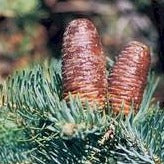Characteristics
The Colorado fir is also called the gray fir. The botanists call the pine plant Abies concolor. The conifer can reach a stature height of up to 30 meters and a stature width of up to 80 meters. The growth can be described as narrow and upright.
Pollination as well as needlework
Abies concolor is monoecious. There is both cross-pollination and wind pollination. The needle-shaped leaves have a smooth leaf edge in addition to a triangular leaf shape. The Colorado fir is an evergreen conifer.
Soil condition
Abies concolor prefers a humus-rich and sandy soil with a moderate nutrient content. The Colorado fir is also a lime-tolerant conifer. In addition to moderate soil moisture, Abies concolor also gratefully accepts sunny and partially shaded locations.
Provenance
The common name of this conifer indicates the North American origin of the tree. Accordingly, Abies concolor can often be found in the US state of Colorado. However, stocks are also found in other states of the USA. The colorado fir is particularly popular in Oregon and southern California.
Uses
Abies concolor is versatile. It is often used as an ornamental tree in parks. The wood is often used in the pulp industry to make paper. Otherwise, the frost-hardy and relatively undemanding colourado fir does a good job in the production of plywood. Abies concolor is also often used as a Christmas tree in the United States, ensuring a harmonious end to the year.




